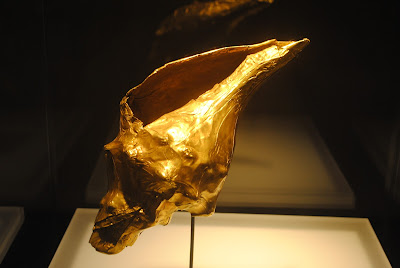The first night we got to the hotel I was tired. The flight from Panama to Bogota was only about an hour; however, I was still getting over my last leg of my ear infection. Doing nothing proved to be useful though since our first full day of Bogota was the start of something awesome!
We took a tour of the graffiti in La Calendaria district of Bogota. During our tour, we learned about the significance of the graffiti in Bogota and why some shop owners pay for artists to paint on the outside of their buildings. In essence, a nice mural is likely to add more value to a building. It also prevents the building from being tagged with something less appealing. The tour taught us about art culture and politics also, since the graffiti is more than just scribbles and profanity.
After the tour Robert and I went to a gold museum. The museum was nice, but not especially anything we cared about. Learning about the history of gold in Colombia was interesting, but not a highlight of our trip. You can't win them all.
The next day we took a private cooking class and learned how to make a Colombian dish. Robert and I made slightly different variations because of me being a vegetarian, but the result was still a lot of awesomeness. Some of the things we made we were familiar with thanks to Panama. Familiar foods included arepas (a corn tortilla thicker than a Mexican tortilla. Can be filled or used like toast or a tostada shell) and patacones (plantains that are deep friend into medallions).
Others though were a fun treat including making a dish with tomatoes and onions called hogao. Another dish we made is called guiso. Basically it is hogao with cheese. However, according to our instructor, there is no such thing as hogao con queso (cheese) . One thing that surprised me was what Colombians put in guacamole. Growing up my mom basically put jalapeños in with mashed avocado. In Colombia they put a sliced boiled egg. Spiciness is added depending on the person, but food in Bogota is generally not spicy. We also tried lulo juice. Lulo is a Colombian fruit that looks like a tomato in ways, but is orange and slightly hairy on the outside. After cutting and peeling the lulo, water and sugar were added to make a refreshing drink.
After our class we ventured back over to the La Calendaria district for some shopping. We met an artist whose work we saw on the tour. Robert bought one of his paintings. The guy seemed nice, despite there being a slight communication barrier.
We then found our way to Mount Monseratti. The entrance was about a mile uphill from where we were, but a lot of people seemed to be taking the walk. From the entrance you can go to the top one of two ways: cable car or on a train. We chose to take the train up and the cable car down. This was a beautiful way of gaining appreciating of how big Bogota is (population estimates at roughly 9.9 million). The views were spectacular.
Our next adventure occurred the next day where we decided to take it a little easy. We walked to Parque Simon Bolivar. The park is bigger than Central Park in New York City. We went on a weekend and both of us were glad we did. There was a lot going on from people playing soccer, to a rugby match in sand and a cross country meet. The park even has an amusement park which includes a ferris wheel sponsored by Samsung.
After walking through that park, we found another one across the road. Robert and I spent time watching speed skaters of all ages and abilities, people playing street hokey, and others playing sand volleyball. It was something else and made me forget about being in a giant city. We then explored in a mall and saw the movie La La Land. The movie was in English. The lobby of the theater was different since there was the typical concession stand, along with a coffee shop, a candy kiosk, and a sushi bar. La La Land is a really good movie, making it a great way to end the day.
Our last day was more of a trip. We went to the Nemocon Salt Mines. It took roughly 2 hours via public transportation and bus to get to the town with the mines. Once we got there we ate a hearty breakfast and found our way to the mines. The salt mine is a cave and is not currently being mined. The optical illusions were beautiful.
This was also a filming location for the movie The 33 which is about the 33 miners who were buried alive in Chile (and also another good movie). We were able to see a replica of the room the miners were trapped. On our way back, we got lunch. Lunch consisted of beans/lentils with a ripe plantain, rice, eggs/beef, a potato, salad, and guava juice. Our bill was roughly $3 US Dollars.
The trip to Bogota went by fast but it was fun to be able to see and experience all we did. Not only did we get a chance to make some really delicious food, we also got see a lot of interesting things in addition to learning about some of Colombia's history.













